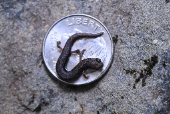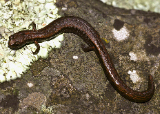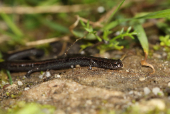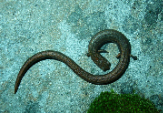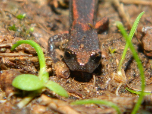Hell Hollow Slender Salamander (Batrachoseps diabolicus)
Description: Adults are 1 to 1/4 to 1 7/8 inches long from snout to vent. A small slim salamander with a relatively broad head and slightly defined neck. Short limbs, a long slender body with a narrow head and a long tail, and conspicuous costal and caudal grooves give this species the worm-like appearance typical of most Slender Salamanders. Limbs are fairly long, and hands and feet are large compared to most Slender Salamanders. Fingers/toes are long and distinct, with expanded tips. There are four toes on the front and hind feet, which is also typical of Slender Salamanders. (Other California salamanders have five toes on the hind feet.) Coloration is dark dorsally with a brownish stripe that is usually brighter at it's edges and continues onto head. There is extensive pale speckling on both the dorsal surface and the grey ventral surface.
Habitat: Populations tend to occur along riparian zones in close proximity to large rivers and streams in pine-oak woodland and chaparral communities. North-facing slopes are preferred, and individuals are usually found beneath rock talus and large stones and other surface cover shaded by oak trees that dominate the region. Summer temperatures are extreme with no rainfall.
Range: Endemic to the foothills of the western slopes of the Sierra Nevada in California, from the lower American River drainages in El Dorado County to Sweetwater Creek, Mariposa County.
Found in these States:
CA
Diet: Eats small invertebrates. A sit-and-wait predator, using a projectile tongue to capture prey.
Reproduction: Reproduction is terrestrial. Lays eggs on land, probably in the rainy season from November to January. Nest sites are not known. Young hatch fully formed.
Status: Listed as Least Concern in view of its relatively wide distribution, presumed large population, and because it is unlikely to be declining fast enough to qualify for listing in a more threatened category, therefore making this the most appropriate category based on the information currently available.
»» Kingdom: Animalia - Animals
»» Phylum: Chordata - Chordates
»» Subphylum: Vertebrata - Vertebrates
»» Class: Amphibia - (Amphibians)
»» Order: Caudata - Salamanders
»» Family: Plethodontidae - Lungless Salamanders
»» Genus: Batrachoseps
»» Species: Batrachoseps diabolicus - Hell Hollow Slender Salamander
This article uses material from the Wikipedia article "Hell Hollow Slender Salamander", which is released under the Creative Commons Attribution-Share-Alike License 3.0. Content may have been omitted from the original, but no content has been changed or extended.
|



